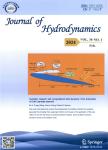An improved predictive-corrective incompressible smoothed particle hydrodynamics method for fluid flow modelling
一为液体流动建模改进了预兆校正的不可压缩的弄平的粒子水动力学方法作者机构:ESS Engineering Software Steyr GmbH Berggasse 35 4400 Steyr Austria Institut Jur Geotechnik Universitat jur Bodenkultur Feistmantelstrasse 4 1180 Vienna Austria
出 版 物:《Journal of Hydrodynamics》 (水动力学研究与进展B辑(英文版))
年 卷 期:2019年第31卷第4期
页 面:654-668页
核心收录:
学科分类:12[管理学] 1201[管理学-管理科学与工程(可授管理学、工学学位)] 08[工学]
基 金:Project supported by the Austrian Research Promotion Agency (Grant No. 865963) the National Natural Science Foundation of China (Grant No. 51709230)
主 题:Smoothed particle hydrodynamics incompressibility predictive-corrective scheme high efficiency
摘 要:Predictive-corrective incompressible smoothed particle hydrodynamics (PCISPH) is an efficient SPH variation originally developed for computer graphics. Its application in modeling physics-focused fluid flows has not yet been reported. In this work, an improved PCISPH method is presented for physics-focused fluid flow modeling. Different from traditional weakly-compressible SPH (WCSPH) and incompressible SPH (ISPH), PCISPH satisfies the incompressibility requirement at the particle level without a predefined equation of state. The pressure is obtained using an iterative predictive-corrective scheme at each individual particle. The presented PCISPH allows much larger time steps compared with WCSPH. It also avoids the time-consuming solution of Pressure Poisson Equation (PPE) in ISPH. Consequently, the PCISPH has high computational efficiency even with millions of computational particles. To ensure physically correct modeling of fluid flows, we employ several techniques to enhance the accuracy and stability of the PCISPH:(1) the continuity equation is used to predict density, replacing the mass summation approach used in the original PCISPH,(2) numerical diffusion and pressure smoothing are introduced to improve the pressure computation,(3) a generalized boundary treatment approach which can handle arbitrarily complex geometries is employed,(4) an adaptive time-stepping algorithm is used, allowing efficient simulation as well as ensuring stability. The performance of the improved PCISPH is systematically investigated using three standard SPH validation cases. Comparisons between the improved PCISPH and the state-of-the-art 5 - SPH are presented. It is found that the improved PCISPH gives numerical results as accurate as J - SPH, except for having moderate temporal pressure oscillations. However, the numerical results show that the improved PCISPH is approximately five times faster than 8 -SPH. The improved PCISPH method shows to be a promising tool for large-scale thre



